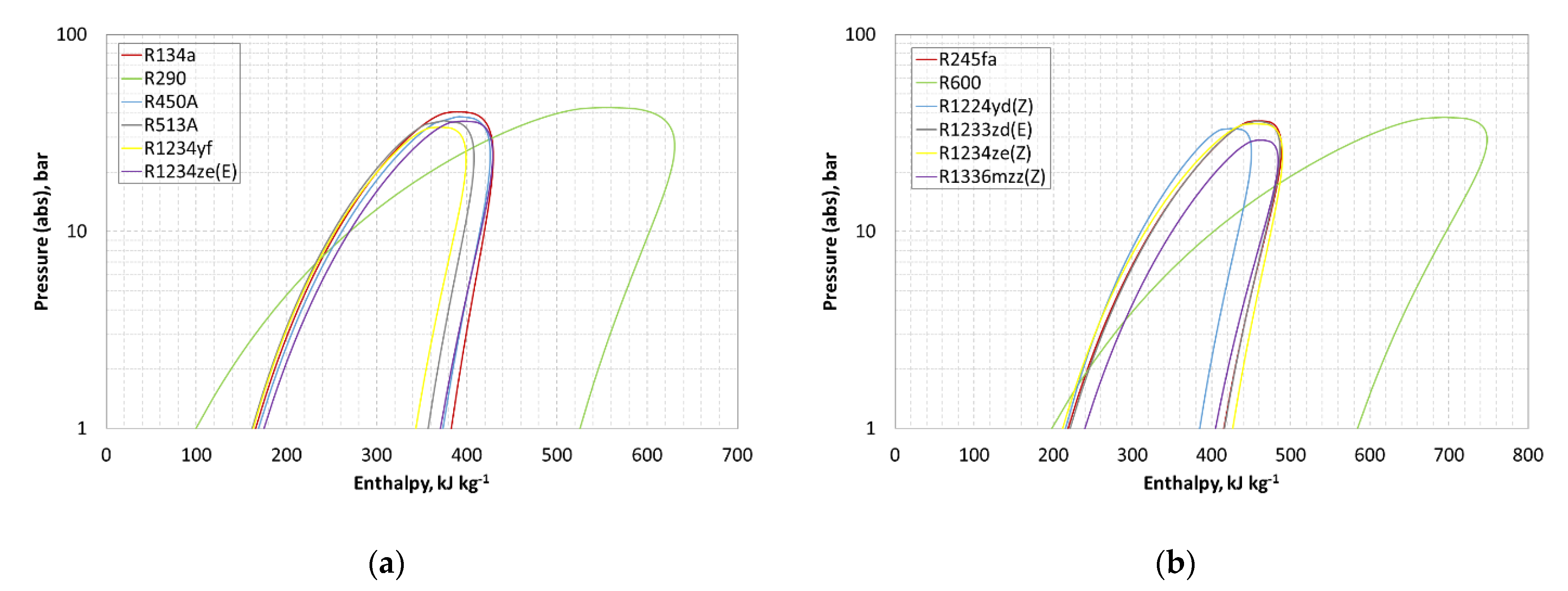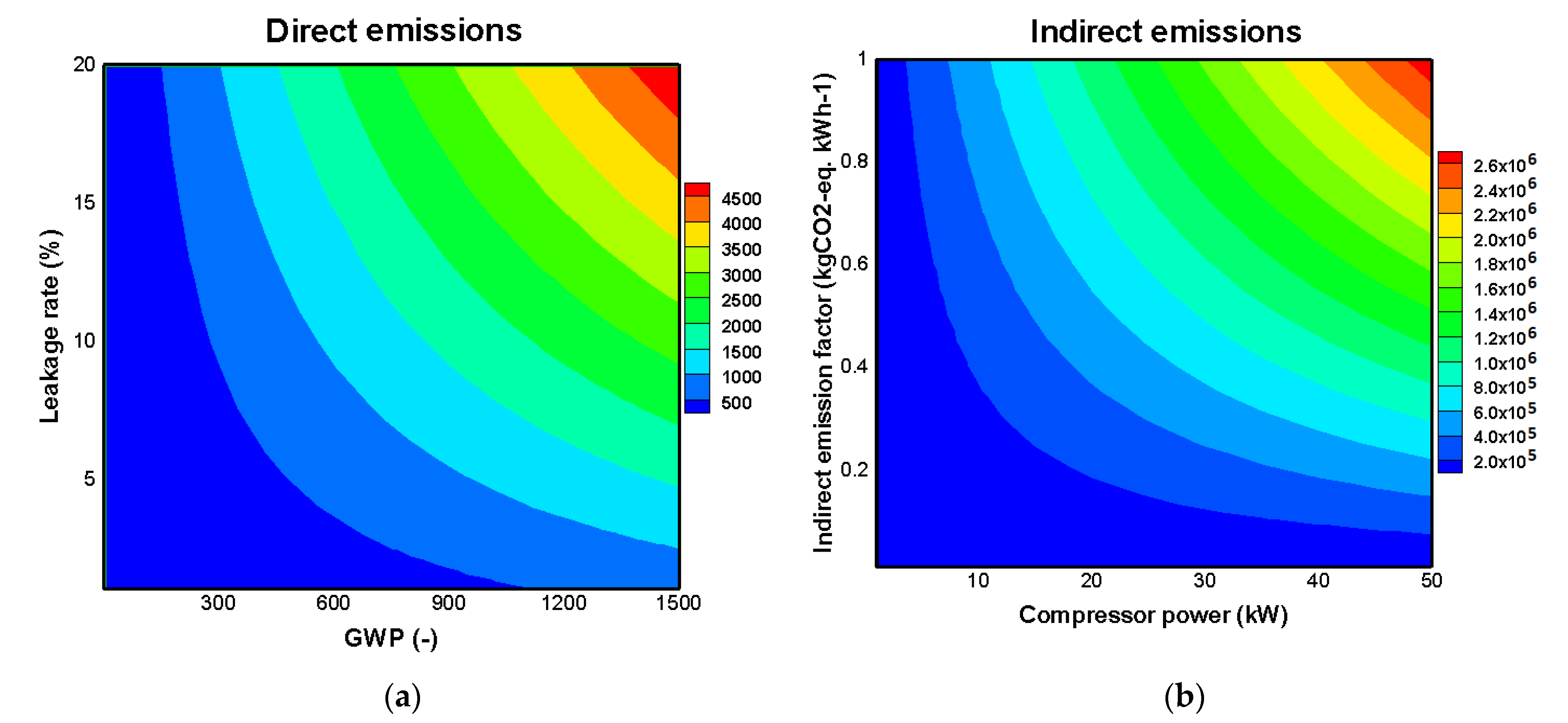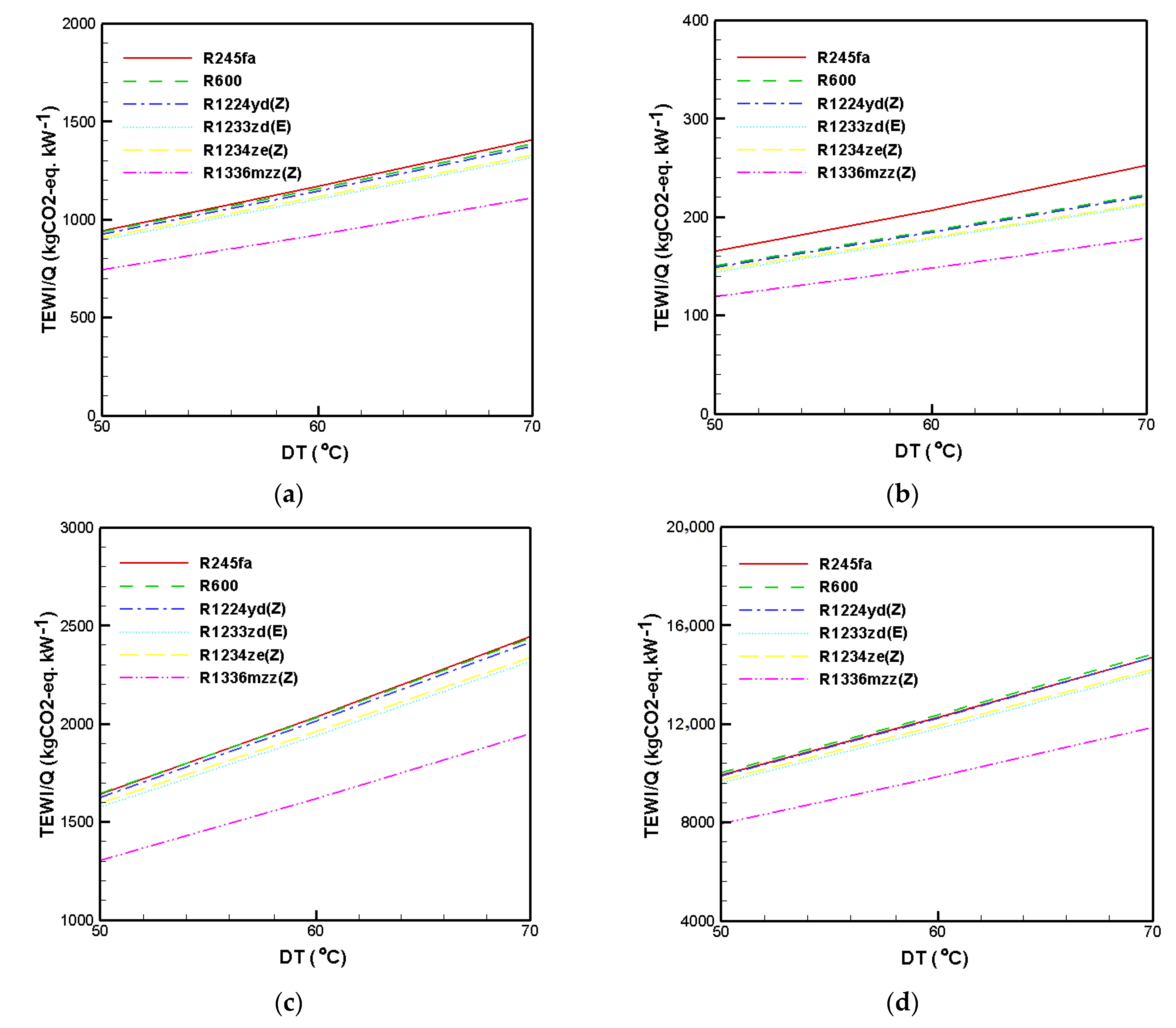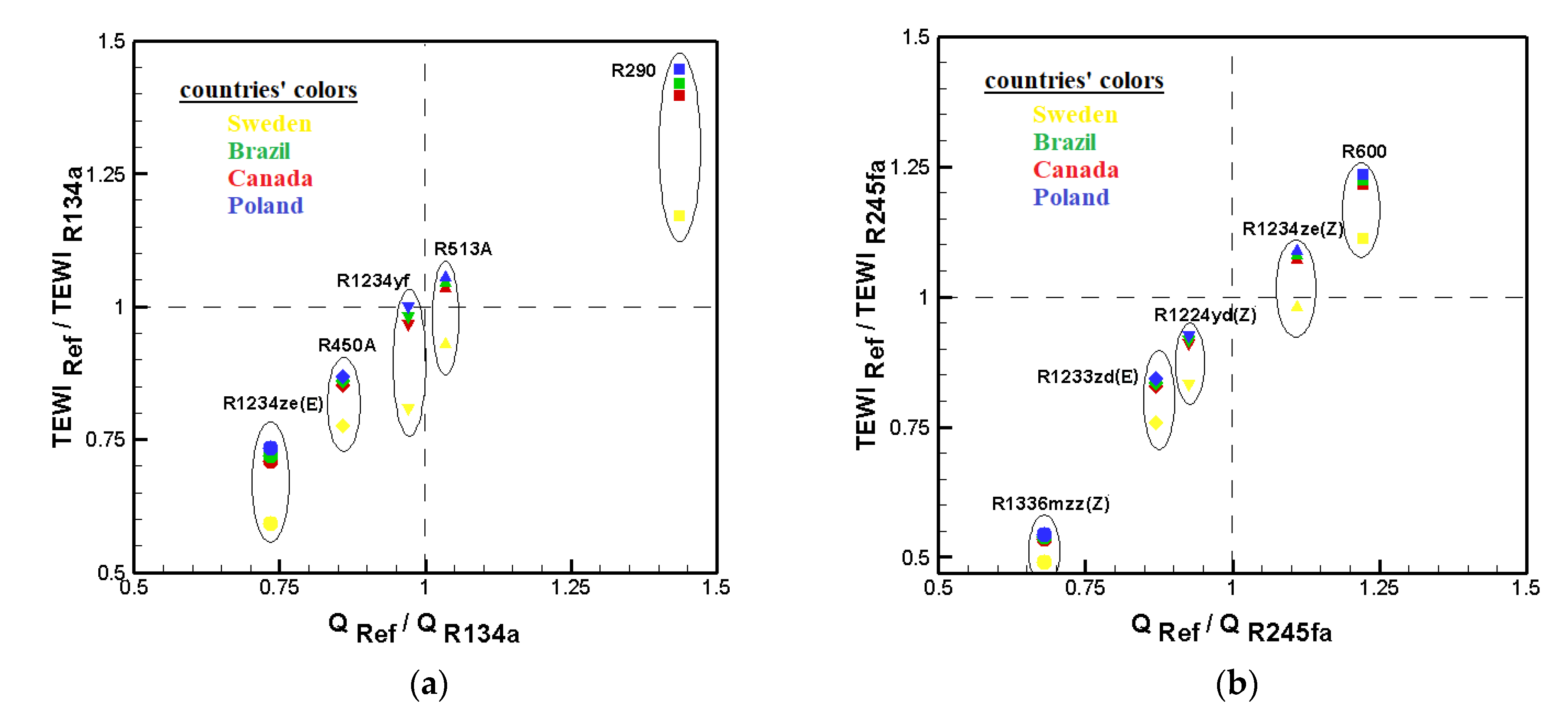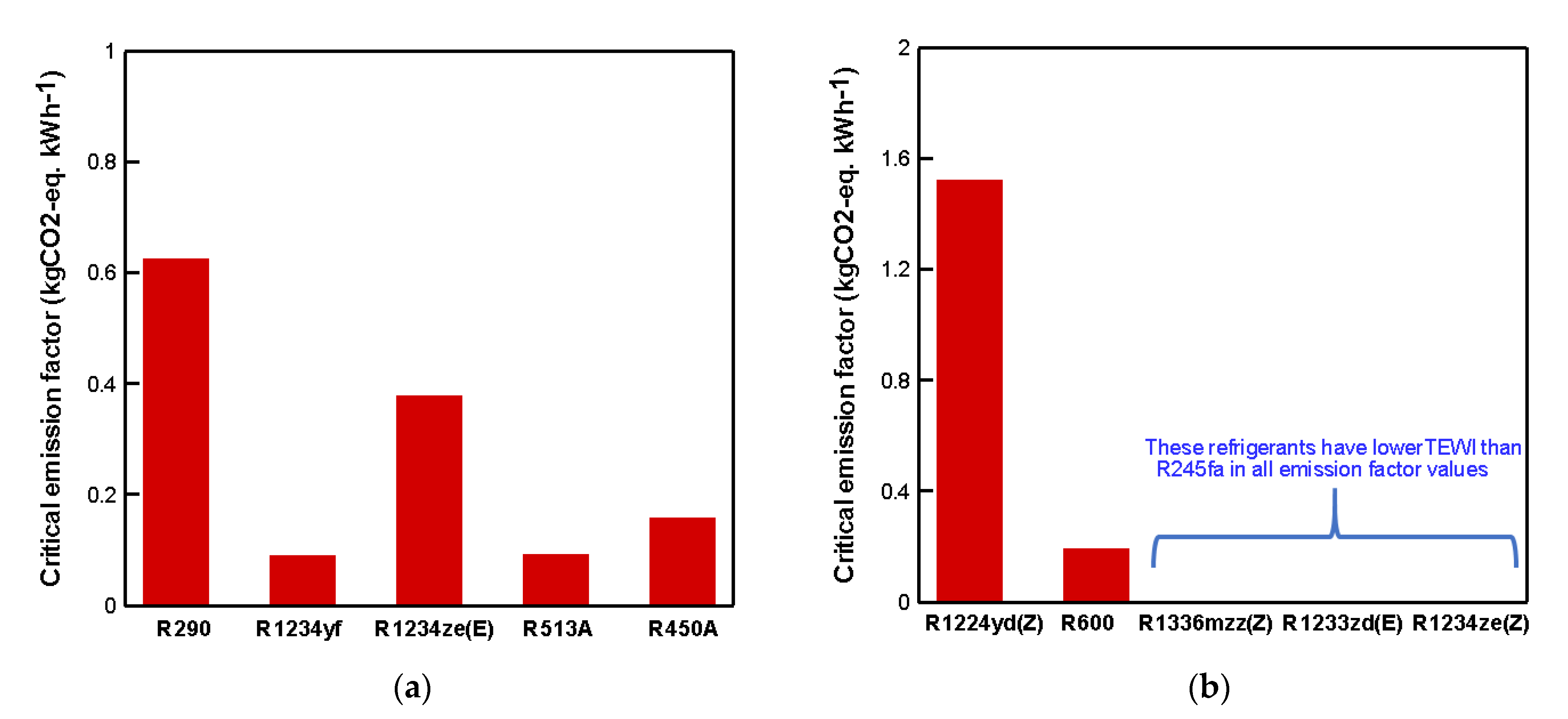1. Introduction
Today, it is confirmed that the human-made emissions of greenhouse gases (GHGs) are responsible for climate change [
1]. One of the sectors with a noticeable contribution to GHGs emissions is the refrigeration, air conditioning and heat pump (RACHP) sector. It is estimated that the RACHP sector was responsible for 349 MtCO
2-eq. in 2010 and is predicted to pass 1596 MtCO
2-eq. in 2030 [
2]. According to the International Institute of Refrigeration (IIR), 37% of GHG emissions were related to indirect emissions caused by electricity consumption of the refrigeration systems and 37% was related to direct emissions due to the escapes of refrigerants [
3,
4].
After global efforts to phase out the chlorinated fluids to protect the ozone layer, as a result of the Montreal protocol [
5], it was time to focus on phasing down/out of GHGs to reduce the emissions of these gases. These efforts were started in 1997 by signing the Kyoto protocol. Later, it was reinforced through the F-Gas Regulation in the European Union in 2014 and the Kigali amendment to reduce the use of hydrofluorocarbon (HFC) refrigerants by 80% until 2047 [
6,
7,
8]. Although the Montreal protocol covered the chlorinated products, it is worth mentioning that the phase-out of chlorofluorocarbon (CFC) refrigerants, as the chlorinated products, reduced global warming by 25% [
9]. This is due to the very high global warming potential (GWP) values of CFCs.
To reduce the GHG emissions of the RACHP sector, alternative refrigerants with lower GWP values have been developed to substitute currently used HFCs with higher GWP. The global warming impact of the RACHP system is associated with direct and indirect emissions. Therefore, the GWP values of the alternative refrigerants and the energy efficiency of the system operating with these refrigerants must be taken into account [
10,
11]. Different metrics have been proposed to quantify the equivalent environmental impact of the RACHP systems [
12]. The Total Equivalent Warming Impact (TEWI) is one of the metrics widely used to quantify the direct and indirect equivalent CO
2 (CO
2-eq.) emissions of the RACHP systems [
13].
In many studies, TEWI is used to investigate the warming impact of RACHP systems and the benefit of alternative refrigerants to reduce the CO
2-eq. emissions [
14,
15,
16,
17,
18,
19,
20,
21]. Rasti et al. [
14,
15] investigated the influence of using R134a, R436A and R600a in a domestic refrigerator. Their results revealed that R436A and R600a reduced the TEWI by 16 and 21% compared to R134a. The TEWI analysis was performed by Belman-Flores et al. [
16] to study the warming impact of a domestic refrigerator with automatic defrost when using R134a and R1234yf. They reported that by using the Mexican Norm NOM-015-ENER-2012, and the CO
2-eq. emissions of the electricity production in Mexico, the use of R1234yf increased the TEWI of the system. Makhnatch et al. [
17] investigated the TEWI of a supermarket refrigeration system designed for R404A and retrofitted by R449A. Considering two different refrigerant leakage rates, they reported that R449A, instead of R404A, reduced the TEWI of the refrigeration system by 50 and 16% at the leakage rates of 12 and 0.4%, respectively. A comparison between an R744 transcritical cycle and a commercial refrigerator operating with R134a was made by Aprea et al. [
18]. They studied the influences of the refrigerant charge amount and the utilization of an internal heat exchanger (IHX) to reduce the TEWI of the refrigeration systems. Their study revealed that IHX reduced the TEWI by about 3% due to the improvement of the system’s energy efficiency. They also reported the optimum refrigerant charge amount that minimizes the TEWI of the system.
The objectives of the regulations related to the GHGs emissions indicate that the main focus of these regulations is on limiting the direct emissions of the RACHP systems by a stepwise phase-down/out of GHGs with relatively high GWP values. To understand the real impact of a refrigeration system, the indirect emissions also need to be calculated. The energy efficiency of the refrigeration system is affected by the design of the system and the selection of the working refrigerants [
10,
22]. In many studies, the energy efficiency of the refrigeration systems operating with refrigerants alternative to commonly used HFCs has been investigated [
23,
24,
25,
26]. Mateu-Royo et al. [
23] performed a comparative analysis to investigate the influence of using R1234ze(E) and R515B as low-GWP replacements to R134a energy performance and environmental impact of heat pump systems. Their results showed that the alternative refrigerants exhibited a comparable coefficient of performance (COP) to R134a. Consequently, the TEWI was reduced by 18 and 15% when using R1234ze(E) and R515B, respectively, due to their much lower GWP values than R134a. Another analysis was done by Mateu-Royo et al. [
24] to study the capability of R1224yd(Z), R1233zd(E) and R1336mzz(Z) as low-GWP alternatives to R245fa in a high-temperature heat pump (HTHP). According to their results, the COP of the system increased by 27, 21 and 17% when using R1233zd(E), R1336mzz(Z) and R1224yd(Z), respectively. The lower GWP values, and the improvement of the system’s energy performance using the alternative refrigerants, resulted in a 59 to 61% reduction in the TEWI, compared to R245fa. Makhnatch et al. [
25] experimented with studying the refrigeration system’s energy performance operating with R134a and its drop-in replacements, including R450A and R513A. They found that the COP of the refrigeration system increased by 1.8% when using R513A in comparison with R134a, but the R450 COP value was 5.3% lower than that of R134a. Mota-Babiloni et al. [
26] investigated the energy performance of an HTHP cascade system equipped with an IHX that operated with low-GWP alternatives to HFCs. Their study included R1233zd(E), R1336mzz(Z), R1224yd(Z) and pentane in the high-stage cycle, and R1234yf, R1234ze(E), butane, isobutene and propane in the low-stage cycle. Their study showed that R1336mzz(Z) and pentane provided the highest system performance in the high-stage cycle. The system’s best performance was observed when using pentane/butane with 13% higher COP compared to the R245fa/R134a refrigerants.
In this study, the warming impact of the heat pump systems operating with different low-GWP alternatives to R134a and R245fa as the most commonly used HFCs, is investigated. The study includes the use of five low-GWP refrigerants for each baseline HFC, and it is extended to four countries with different levels of emissions in their electricity production. The aim of this work is to promote the utilization of the TEWI metric to describe the influence of different alternative refrigerants on the warming impact of heat pump systems. This study provides a comprehensive view of the potential of low-GWP refrigerants to be used as a replacement to R134a and R245fa while considering the direct and indirect CO2-eq. emissions.
2. Methodology
A single-stage heat pump is selected as the reference to investigate the influence of alternative refrigerants to R134a and R245fa on the warming impact. The heat pump system comprises a compressor with an efficiency of 70%, a condenser, an evaporator and an expansion valve. The superheating and subcooling temperatures are assumed to be 5 K. Due to the high GWP of R134a and R245fa, these HFC refrigerants should be replaced, and they are set as the reference refrigerants in this study. The analysis of the heat pump system is divided into two parts. First, the comparison between R134a and its five selected alternative refrigerants was made in a medium temperature heat pump (MTHP) when supplying a condensation temperature of 40 °C. Second, R245fa and its five selected alternative refrigerants are employed in an HTHP to supply a condensation temperature of 100 °C.
The selected refrigerants and their properties are listed in
Table 1, and the pressure-enthalpy diagrams of these refrigerants are shown in
Figure 1. The selected low-GWP refrigerants have comparable thermophysical properties to those of the reference refrigerants. The alternative refrigerants have lower toxicity than R245fa, as this refrigerant belongs to the ASHRAE safety class B1. It is also worth highlighting that the selected hydrocarbons (R290 and R600) are included in group A3 due to their higher flammability. R1234yf, R1234ze(E) and R1234ze(Z) are considered to be lower flammability refrigerants and belong to the A2L group. Other selected refrigerants are non-flammable according to the ASHRAE safety class. Concerning the ozone depletion potential (ODP), all selected refrigerants have a zero ODP except R1224yd(Z) and R1233zd(E), which are known as hydrochlorofluoroolefin (HCFO) refrigerants. It is noted that the ODP of these two refrigerants is very small (almost zero), which meets the requirements laid out by current national environmental regulations.
Most of the alternative refrigerants to R134a and R245fa have similar two-phase regions to the reference refrigerants apart from the hydrocarbons (R290 and R600). In R134a and its alternative refrigerants, the critical temperature of R290 is much higher than R134a, but in other selected refrigerants, it is almost equal to or less than that of R134a. In contrast, the alternative refrigerants to R245fa, except R1224yd(Z), have almost equal or even higher critical temperatures than R245fa, demonstrating a potential for performance improvement using alternative refrigerants compared to R245fa.
Since the electricity generating sources have a significant influence on indirect emissions and consequently on TEWI, four countries where the electricity is generated using different sources are selected in this study. These countries include Brazil, Sweden, Canada and Poland, where β values are 0.074, 0.012, 0.130 and 0.791 kgCO
2-eq. kWh
−1, respectively [
28]. As shown in
Figure 2, in Sweden, the main sources of electricity generation are clean and renewable energies, resulting in much lower emissions than countries such as Poland, where coal is the main source of electricity generation.
To investigate the warming impact of the heat pump system, the TEWI metric is employed in this study. The TEWI, a commonly used metric to investigate the GHGs missions in RACHP, was developed by the US Department of Energy and Oak Ridge National Laboratories [
13]. The TEWI is comprised of two parts, including the direct and indirect emissions of GHGs. The accidental leakage of refrigerants cause direct emissions, and the electricity consumption causes indirect emissions during the refrigeration system operation. The TEWI is calculated as shown in Equation (1) [
30]:
where
L,
n,
m,
,
, and
are leakage (kg per year), system operating time (year), refrigerant charge (kg), recovery factor (%), annual energy consumption (kWh) and carbon emissions factor (kgCO
2-eq. kWh
−1) related to electricity generation, respectively. It is noted that the TEWI is subjected to a certain amount of uncertainty [
31,
32]. It is due to the large degree of uncertainty and assumptions related to the TEWI parameters.
3. Results and Discussion
When replacing a refrigerant in a refrigeration system, it is important to investigate the system’s energy performance. In
Figure 3 and
Figure 4, the COP, heating capacity and compressor discharge temperature when using the alternative refrigerants to R134a and R245fa are shown and compared. The
x-axis represents the difference between condensation and evaporation temperatures (DT). The condensation temperatures are assumed to be fixed at 40 and 100 °C in MTHP and HTHP applications, respectively, while the evaporation temperature varies to provide the desired DT.
In the MTHP application, R134a has the highest COP among the DT range of 50–70 °C, while the COP values of R1234ze(E), R290 and R450A are close to the COP of R134a. Among tested refrigerants, R1234yf has the lowest COP, which is on average 4% lower than R134a. The comparison between the heating capacity of the refrigerants revealed that the utilization of R290 could provide greater heating capacity than other refrigerants at a given DT. The heating capacity of R290 and R513A is larger than that of R134a, while the heating capacity of R1234ze(E) is lower than that of other refrigerants. The discharge temperature analysis of the refrigerants in the MTHP application revealed that all the alternative refrigerants have lower discharge temperatures than R134a. The lowest discharge temperature belongs to R1234yf, which is 15 °C, on average, lower than that of R134a.
In the HTHP application, the COP of the R1336mzz(Z) is higher than that of other refrigerants. The COP of R1336mzz(Z) is 24%, on average, higher than that of R245fa. It was also found that R1233zd(E) and R1234ze(Z) have higher COP than R245fa, but R600 exhibits the lowest COP among all the tested refrigerants. Although R600 shows the lowest COP value, this refrigerant provides the highest heating capacity, which is 27%, on average, higher than that of R245fa. The lowest heating capacity is observed when using R1336mzz(Z) and maintains a heating capacity value of less than 40 kW over the operating range. Among alternative refrigerants, R1336mzz(Z), R1234ze(Z) and R1233zd(E) have higher discharge temperatures than R245fa, while the highest discharge temperature belongs to R1336mzz(Z). The discharge temperature of R1336mzz(Z) is on average 19 °C higher than that of R245fa. The discharge temperatures of R1224yd(Z) and R600 are very close to that of R245fa, mostly below 104 °C.
The direct and indirect emissions of a heat pump system are shown in
Figure 5. The contour of the direct emissions for each kilogram of refrigerant charge confirms that the increment of the leakage rate, and GWP of the refrigerant, increase the direct CO
2-eq. emissions remarkably. It is also revealed that for the refrigerants such as R290, R1234yf, R1234ze(E), R1336mzz(Z), R1233zd(E), R1224yd(Z), and R1234ze(Z) with very low GWP values, the increase in the leakage rate does not have a noticeable influence on direct emissions. However, for the refrigerants such as R134a and R245fa with much higher GWP values, the direct CO
2-eq. emissions increase significantly with an increase in the leakage rate. This result indicates that the direct CO
2-eq. emissions can be negligible by the utilization of refrigerants with very low GWP values in RACHP systems.
The analysis of the indirect CO2-eq. emissions revealed that both the indirect emissions factor and the heat pump system’s power consumption have a remarkable influence on the indirect emissions. When the source of electricity is clean energy, such as nuclear or renewable energies, the indirect emissions factor decreases with the CO2-eq. emissions for the generation of each decrease in kWh. This results in a reduction of the indirect CO2-eq. emissions of the RACHP systems. Furthermore, the electricity consumption of the RACHP system, which is inversely proportional to the COP of the system, influences the indirect CO2-eq. emissions. Hence, the utilization of refrigerants that increase the system’s energy efficiency or any modifications in the system’s design can decrease the electricity consumption of the RACHP systems and consequently reduce the indirect CO2-eq. emissions.
The TEWI per kilowatt heating capacity (TEWI/Q) of MTHP and HTHP using the alternative refrigerants is presented in
Figure 6 and
Figure 7, respectively. In
Figure 6, it is observed that for the economies with low carbon intensity values, such as Sweden and Brazil, the TEWI/Q of R134a is higher than its alternative refrigerants. Although the COP of R134a is higher than other selected refrigerants, very low β values in Sweden and Brazil compensate for the lower COP of alternative refrigerants. For economies with relatively higher carbon indexes, such as Canada and Poland, the lower COP of R1234yf makes this refrigerant the worst case among tested refrigerants. However, it has an ultra-low GWP value. This means that direct emissions are the main contributors to the TEWI/Q in countries such as Canada and Poland, with relatively higher β values. Moreover, R1234ze(E), as an energy-efficient case with an ultra-low GWP value, is almost the best refrigerant in terms of TEWI/Q in all tested countries, except in Poland, where R134a showed the minimum emissions. This is due to a much higher β value in Poland than the other selected countries, which dominate the role of electricity consumption and consequently indirect emissions on TEWI/Q.
Comparing the TEWI/Q of the alternative refrigerants to R245fa (
Figure 7), the results illustrate that R1336mzz(Z) achieves the lowest environmental impact in all selected countries. Due to the much higher COP of the system using R1336mzz(Z) and its ultra-low-GWP value. Similar to R1336mzz(Z), it was also found that R1233zd(E) and R1234ze(Z) have lower TEWI/Q compared to R245fa due to their higher COP and lower GWP values. In a country such as Sweden, with a relatively small β value, the TEWI/Q of R245fa is notably higher than the alternative refrigerants, which means the HTHP system can benefit from utilizing alternative refrigerants. In Poland, where there is a relatively higher β value than other selected countries, R600 presents a slight TEWI/Q increase compared to R245fa as it exhibits lower COP compared to other tested refrigerants.
It is important to note that irrespective of the type of refrigerants, the value of the TEWI/Q is strongly affected by the β value. For instance, the β value in Poland is more than ten times greater than that in Sweden; and consequently, the TEWI/Q using alternative refrigerants to R245fa in Poland is on average 65 times higher than in Sweden. Moreover, the analysis results depict countries with low carbon intensity values, such as Sweden and the CO2-eq. emissions of RACHP systems using HFCs are much lower than countries with high carbon-intensity values, even if low-GWP refrigerants are employed in RACHP systems in those countries. This is since the contribution of indirect emissions to the TEWI is much higher than that of the direct emissions of the RACHP systems. The results confirmed that the TEWI/Q values of R134a and R245fa in Sweden are much lower than the TEWI/Q of the alternative refrigerants in other selected countries.
As all proposed refrigerants alternative to R134a and R245fa have lower GWP values, the energy efficiency analysis can determine the TEWI/Q of the system. A higher COP of a refrigerant can guarantee a lower TEWI/Q. The reason for this is that the proposed alternatives have lower direct emissions due to their lower GWPs. In comparison, higher COPs can lead to lower indirect emissions as this parameter is inversely proportional to the system’s energy efficiency. The comparison between the heating capacity and TEWI of the alternative refrigerants and the reference GHGs including R134a and R245fa, is presented in
Figure 8. In the MTHP application, R290 provides a 45% greater heating capacity than R134a under the same operating condition (DT = 50 °C), but the utilization of R290 increases the TEWI by 16–45%, in selected countries. The TEWI of R1234yf is very close to the TEWI of R134a, except in Sweden, where the TEWI of R1234yf is 30% lower than R134a. Interestingly, R513A provides an 8% lower TEWI and a 4% higher heating capacity in Sweden, which is the only case among all tested refrigerants and selected countries. A reduction in TEWI accompanies the increment in heating capacity compared to R134a. Although R1234ze(E) and R450 have lower TEWI than R134a, they also provided 15–26% lower heating capacity.
In the HTHP application, R600 provides the highest heating capacity, which is 24% greater than R245fa. A TEWI increment between 10 and 26% is expected in selected countries when using this refrigerant. The lowest TEWI belongs to R1336mzz(Z), accompanied by the lowest heating capacity compared to other refrigerants. The heating capacity of R1336mzz(Z) is 32% lower than R245fa and its TEWI decreases between 45 and 53% compared to the reference refrigerant. R1234ze(Z) provides an 11% higher heating capacity than R245fa, but its TEWI is 7–10% higher in the selected countries, except in Sweden. A reduction in TEWI by 2% is found in Sweden, making it the only case with a higher heating capacity, accompanied by a lower TEWI than R245fa. Meanwhile, R1234yd and R1233zd(E) each provide a lower TEWI and heating capacity than R245fa.
Figure 9 represents the critical emission factor, which is the maximum value of β for which an alternative refrigerant has a lower TEWI than its reference refrigerant, including R134a and R245fa in MTHP and HTHP applications. Although the alternative refrigerants have lower GWP and consequently lower direct emissions than the reference refrigerants, the indirect emissions have a crucial impact on TEWI. It means that the COP of the RACHP system is critical, as it is inversely proportional to the indirect emissions. When the COP of the reference refrigerants (R134a and R245fa in this study) is higher than their alternatives, as there is a particular value for β, at which higher values mean that the TEWI of an alternative refrigerant is greater than the reference refrigerant. Therefore, for a RACHP system to benefit from utilizing alternative refrigerants to mitigate warming impact, the β value should be lower than the critical one. For instance, R1234yf has the lowest critical β value among the alternative refrigerants compared to R134a. This means that the value of β should be below 0.09 kgCO
2-eq. kWh
−1 to have a lower TEWI than R134a. This is due to the lowest COP of R1234yf compared to other low-GWP alternative refrigerants. The highest critical β belongs to R290 as it has a higher COP than other alternative refrigerants. For this case, the critical β is found to be 0.63 kgCO
2-eq. kWh
−1.
For alternative refrigerants to R245fa, there is not any critical β for R1336mzz(Z), R1233zd(E) and R1234ze(Z) as these three refrigerants have higher COP and lower GWP than R245fa. This means that both direct and indirect emissions decrease using R1336mzz(Z), R1233zd(E) and R1234ze(Z) at any β value. However, for R1224yd(Z) and R600, there are critical β’s which values are much higher for R1224yd(Z) than R600, as the latter exhibits the lowest COP among alternative refrigerants to R245fa.
